![]()
![]()
![]()
Use LEFT and RIGHT arrow keys to navigate between flashcards;
Use UP and DOWN arrow keys to flip the card;
H to show hint;
A reads text to speech;
38 Cards in this Set
- Front
- Back
- 3rd side (hint)
|
SUPERIOR VIEW OF L2 |
1. transverse process 2. pedicle 3. vertebral foramen 4. body 5. mamillary process 6. superior articular process 7. laminae 8. spinous process |
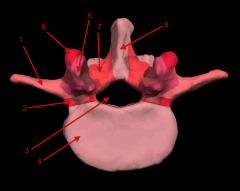
|
|
|
SCOTTY DOG FRACTURE |
PARS INTERARTICULARIS |
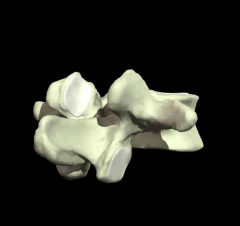
|
|
|
OVERVIEW OF VERTEBRAL COLUMN |
1. cervical region 2. thoracic region 3. lumbar region 5. sacral region |
|
|
|
1. CERVICAL REGION |
LORDOTIC CURVATURE: - convex relative to anterior aspect of body C1 - C7 |
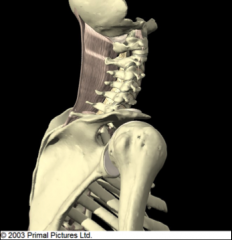
|
|
|
2. THORACIC REGION |
KYPHOTIC CURVATURE: - concave relative to anterior aspect of body T1 - T12 |
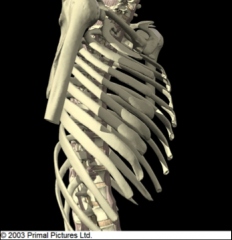
|
|
|
3. LUMBAR REGION |
LORDOTIC CURVATURE:
- convex relative to the anterior aspect of body L1 - L5 |
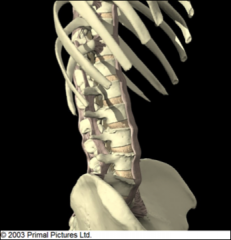
|
|
|
4. SACRAL REGION |
KYPHOTIC CURVATURE: - concave relative to anterior aspect of body S1 - S5 |

|
|
|
DYNAMICS OF PELVIC TIPPING |
1. rectus abdominus - post. tip 2. erector spinae - ant. tip 3. hamstrings - post. tip 4. rectus femoris - ant. tip |
|
|
|
1. RECTUS ABDOMINUS |
- if too strong, creates posterior tip to pelvis - decrease lumbar lordotic curvature |
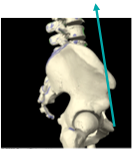
|
|
|
2. ERECTOR SPINAE |
- if too strong, creates anterior tip to pelvis - increase lumbar lordotic curvature - origin = posterior aspect of pelvis - insert = superior vertebra/ribs |
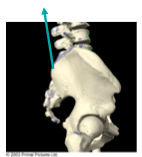
|
|
|
3. HAMSTRINGS |
- if too strong, creates posterior tip to pelvis - decrease lumbar lordotic curvature - all three hamstrings origin = ischium |
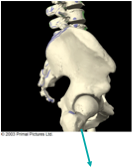
|
|
|
4. RECTUS FEMORIS |
- if too strong, creates anterior tip to pelvis - increase lumbar lordotic curvature - one of "quad" muscles - origin = anterior inferior iliac spine - inserts on patellar tendon |
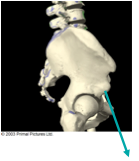
|
|
|
POSTERIOR VIEW OF LUMBAR REGION |
1. lumbar vertebra 1 2. transverse processes 3. spinous processes |
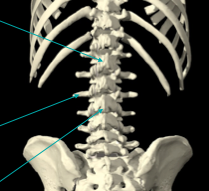
|
|
|
1. LUMBAR VERTEBRA 1 |
- lumbarized - all sacral vertebra should be fused |
|
|
|
2. TRANSVERSE PROCESSES |
- insertion points for ligs/muscles |
|
|
|
3. SPINOUS PROCESSES |
- insertion points for ligs/muscles |
|
|
|
LIGAMENTS IN POSTERIOR LUMBAR REGION |
1. intertransverse ligament 2. interspinalis ligaments 3. ligamentum flava |
|
|
|
1. INTERTRANSVERSE LIGAMENT |
- passes from b.t. the transverse processes of adjacent vertebra - prevent excessive opposite side lateral flexion |
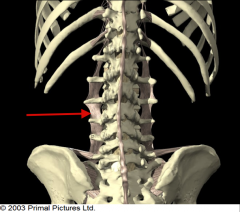
|
|
|
2. INTERSPINALIS LIGAMENTS |
- passes between the spinous processes of adjacent vertebra - prevent excessive forward flexion |

|
|
|
3. LIGAMENTUM FLAVA |
- passes between anterior & inferior aspect of laminae of more proximal vertebra to the posterior & superior aspect of the laminae of the more distal vertebra - prevent excessive forward flexion |
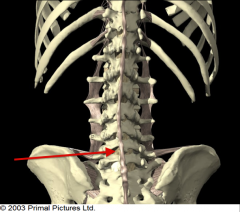
|
|
|
LIGAMENTS IN ANTERIOR LUMBAR REGION |
1. anterior longitudinal ligament |
|
|
|
1. ANTERIOR LONGITUDINAL LIGAMENT |
- limits hyperextension of vertebral column * AKA prevents excessive extension of trunk - inserts into anterior aspect of successive vertebral bodies - thick/broad - rarely injured |
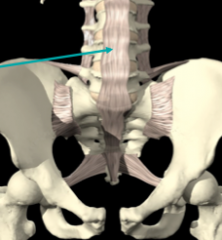
|
|
|
MUSCLES OF POSTERIOR LUMBAR REGION |
1. mulifidus muscle 2. erector spinae 3. thoracolumbar fascia 4. latissimus dorsi |
|
|
|
1. MULIFIDUS MUSCLE |
- stabilizes sucessive vertebra - runs oblique b.t. transverse processes of inferior vertebra to spinous process of superior vertebra - runs length of vertebral col. |

|
|
|
2. ERECTOR SPINAE |
- extends spine if functioning bilaterally - group of muscles |
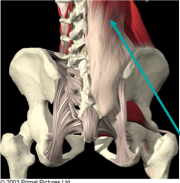
|
|
|
3. THORACOLUMBAR FASCIA |
- binds together all deep muscles of spinal column *AKA multifidus & erector spinae - separates deep muscles from superficial muscles of lumbar region |
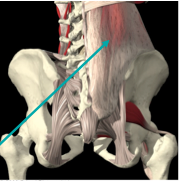
|
|
|
4. LATISSIMUS DORSI |
- adducts & internally rotates humerus - very large muscle - originates on spinous processes of lumbar & thoracic vertebra |
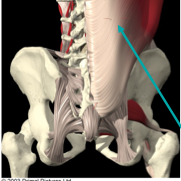
|
|
|
THE INTERVERTEBRAL DISK |
1. intervertebral disk 2. annulus fibrosis |
|
|
|
1. INTERVERTEBRAL DISK |
- b.t. each cervical, thoracic, lumbar vertebra - none b.t. sacral or coccyx - anterior to spinal cord - limited to articulate w. adjacent vertebral bodies - 20-25% of height of vert. col. |
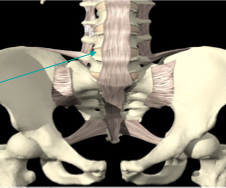
|
|
|
2. ANNULUS FIBROSIS |
- outer region of each disck - very fibrous - primarily collagen bundles - collagen bundles = obliquely oriented - posterior/lateral aspect of disk the bundles = poorly organized --> this leads to weak-spot where nucleus pulposus can break through - when nucleus pulposus migrates away from center of intervertebral disk = disk herniation |
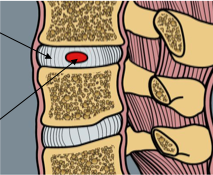
|
|
|
INTERVERTEBRAL DISK HERNIATIONS |
* disk only articulates w. body of adjacent vertebrae * spinal cord housed in vertebral foramen... 1. pedicles 2. laminae 3. spinous process 4. b.t. pedicle & laminae.. 5. neural arch -- 6. protrusion/extrusin/sequestration 7. nerve root damage |
|
|
|
1. PEDICLES |
- found bilaterally - immediately posterior to vertebral body |

|
|
|
2. LAMINAE |
- found bilaterally - immediately posterior to pedicles |

|
|
|
3. SPINOUS PROCESS |
- just posterior to laminae |
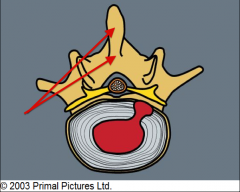
|
|
|
4. B.T. PEDICLES & LAMINAE.. |
- superior & inferior articular process b.t. each pedicle & laminae |
|
|
|
5. NEURAL ARCH |
- bony aspects taken together = neural arch |
|
|
|
6. PROTRUSION, EXTRUSION, & SEQUESTRATION |
PROTRUSION: - if nucleus pulposus bulges against annulus fibrosis EXTRUSION: - if nucleus pulposus bulges through annulus fibrosis SEQUESTRATION: - if nucleus pulposus is no longer bound by annulus fibrosis |
|
|
|
7. NERVE ROOT DAMAGE |
- any herniations in posterior & lateral directions can impinge spinal nerve root - causes sensory (dermatone) and motor (myotome) function damage |
|

